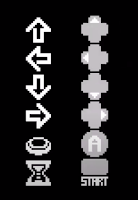Fifty Days of UFO 50: Day 44
WarpTank might be one of the most charming and thought-provoking games in the collection for me. It almost feels weirdly laser-targeted to surprise and confound my specific taste. Take the initial presentation, for example; the minimalist title screen and sparse sci-fi aesthetic will trigger my love of Metroid, right? Well they would, if the music wasn't immediately zigging out on a jazzy café jag instead of zagging into moody atmospherics. Then, some later game tracks are more like what I was expecting... before going full carnival mode once again!
One of the tricks they're using to make WarpTank feel like an older game than it is involves limited animation and scrolling. Your vehicular character is allowed only a single frame of animation between each tile it occupies, and the camera snaps to the tile grid in a way that makes the game less visually smooth. Straining your persistence of vision a bit accomplishes the goal of making it feel less like 2024, but little things like thoughtful collision detection forgiveness and the way the controls flip themselves around and adapt as you defy gravity kind of give the game away. I think I've even encountered a bit of artificial slowdown, (or it's possible that I really do just need to reboot this machine.)
Those comparisons to Metroid go beyond the spacey theme and graphics though. WarpTank shows the "UFO 50 Recovery Team" has an understanding of a specific "show and don't tell" effect that Samus' games used to be all about. It's a quality that's strongest in Super Metroid that I've been struggling to describe for ages, and one that's most likely been lost to that series with no hope of its return thanks to the success of Metroid Prime's "scanning" method of environmental storytelling.
Don't get me wrong, I love scanning stuff and reading about alien ecosystems and fantastical lost technology, but it's a big shift from the visual to the textual. The difference between being an environmental archeologist and a fan reading a cool wiki about the game you're in.
There's a bunch of these story elements you're shown and never told about in Super Metroid, but my favorite one was always in the crashed ship. There's these inactive wall monitors scattered around that come to life later, once you've restored power. The ones that aren't cracked will display a portion of the metroid body plan in a way that tricked me into thinking they were behind glass as a kid. This led to tons of speculation on my part about whether it was a Chozo vessel with the original plans for metroid-based power systems, or a space pirate frigate on a mission to find and research them. Despite them being the focus of my imagined theories for decades, some players didn't even notice these, or saw a green planet with Samus' ship in the corner, or assumed they were mocktroids, all sorts of different reactions. That's the sauce, in my opinion; a lack of fidelity and perfect information providing entertainment that endures beyond the gameplay!
I just know I'm going to struggle to pull something like that off for the rest of my career, given even some modern torchbearers for some of these vibes like Axiom Verge only manage to stab at the edges of aesthetically tantalizing set pieces. Frustratingly, there's evidence that even some of the Metroid creators themselves stumbled into this "visual only mystery" technique that I praise so often thanks to technical limitations. The ones I have to thank might be some background artists putting in details only hinted at or suggested by the scenario planners and directors, because given the content of later titles like Metroid: Other M, directors like Yoshio Sakamoto might have gushed and overshared at the player about some of these details if the technology or gameplay format of the titles had given them room to do so.
So WarTank's got the juice in the form of biomechanical monster parts lying around. At one point you traverse the scaffolding of an enormous skeletal arm, and the builders of this space station appear to be sentient vehicles, as if a dash of Disney/Pixar's Cars is gonna help with my theory-crafting!
There's so many idiosyncratic details in here that I really need to remind myself about how motivated Derek Yu and the others were to jam cross-game connections into everything. I guess it makes sense that there'd be a quaint little café up here given all the hidden coffee? It also took me an embarrassing amount of time to figure out that the terminals scattered around the hub area were just changing my tank's appearance, and not that I was missing some crucial switching mechanism attached to hidden level locations. Goodness knows there's enough hidden stuff all over the place; UFO 50 might be making me somewhat "secret paranoid," if that's even a thing.








Comments
Post a Comment